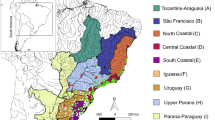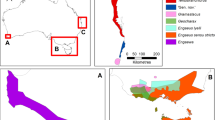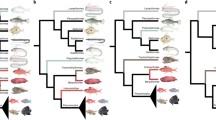Abstract
Cladistic biogeography is an evolutionary biogeographic approach that infers area relationships by comparing area cladograms derived from different phylogenetic hypotheses. The South American freshwater ichthyofauna is enriched by an extraordinary number of marine-derived lineages, presenting its own phylogenetic and biogeographic patterns. Here, we performed a Brooks Parsimony Analysis (BPA) with the latest phylogenetic proposals for Anablepidae to compare hypotheses about the historical relationships among areas previously recognized based on fish species from the Neotropical region. We found that the area relationships for Anablepidae are in accordance with the pattern evidenced for other marine-derived lineages. The general area cladogram obtained shows a three-area relationship pattern, where freshwater is the sister group of Pacific + Atlantic marine areas. Within the freshwater clade, Southern Brazil + Uruguay River basin and Northwestern Argentina + Midwestern Argentina form two clades. Vicariance, dispersal, and extinction events related to Miocene and Quaternary marine transgressions and ancient connections between the Iguaçu and Upper Uruguay River basins supported the historical relationships among areas proposed here. Our results may be applied to patterns shown by other marine-derived lineages, as well as other freshwater organisms not necessarily having marine origins.



Similar content being viewed by others
Data availability statement
Data sharing is not applicable to this article as no datasets were generated or analyzed during the current study.
References
Abell, R., Thieme, M. L., Revenga, C., Bryer, M., Kottelat, M., Bogutskaya, N., Coad, B., Mandrak, N., Balderas, S. C., Bussing, W., Stiassny, M. L. J., Skelton, P., Allen, G. R., Unmack, P., Naseka, A., Ng, R., Sindorf, N., Robertson, J., Armijo, E., Higgins, J. V., Heibel, T. J., Wikramanayake, E., Olson, D., Lopez, H. L., Reis, R. E., Lundberg, J. G., Perez, M. H. S., & Petry, P. (2008). Freshwater ecoregions of the world: a new map of biogeographic units for freshwater biodiversity conservation. Bioscience, 58, 403–414.
Aguilera, G., Terán, G. E., Mirande, J. M., Alonso, F., Rometsch, S., Meyer, A., & Torres-Dowdall, J. (2019). Molecular and morphological convergence to sulfide-tolerant fishes in a new species of Jenynsia (Cyprinodontiformes: Anablepidae), the first extremophile member of the family. PLoS One, 14, e0218810.
Amorim, P. F. (2018). Jenynsia lineata species complex, revision and new species description (Cyprinodontiformes: Anablepidae). Journal of Fish Biology, 92, 1312–1332.
Amorim, P. F., & Costa, W. J. E. M. (2018). Multigene phylogeny supports diversification of four-eyed fishes and one-sided live-bearers (Cyprinodontiformes: Anablepidae) related to major South American geological events. PLoS One, 13, e0199201.
Amorim, P. F., & Costa, W. J. E. M. (2019). Reconstructing biogeographic temporal events in the evolution of the livebearer fish genus Jenynsia based on total evidence analysis (Cyprinodontiformes: Anablepidae). Systematics and Biodiversity, 17, 124–133.
Angulo, R. J., Lessa, G. C., & Souza, M. C. (2006). A critical review of mid- to late-Holocene sea-level fluctuations on the eastern Brazilian coastline. Quaternary Science Reviews, 25, 486–506.
Bloom, D. D., & Lovejoy, N. R. (2011). The biogeography of marine incursions in South America. In J. S. Albert & R. E. Reis (Eds.), Historical biogeography of Neotropical freshwater fishes (pp. 137–144). Berkeley and Los Angeles: University of California Press.
Bloom, D. D., & Lovejoy, N. R. (2017). On the origins of marine-derived freshwater fishes in South America. Journal of Biogeography, 44, 1927–1938.
Bogan, S., Contreras, V. H., Agnolin, F., Tomassini, R. L., & Peralta, S. (2018). New genus and species of Anablepidae (Teleostei, Cyprinodontiformes) from the Late Miocene of Argentina. Journal of South American Earth Sciences, 88, 374–384.
Brea, M., & Zucol, A. F. (2011). The Paraná-Paraguay basin: geology and paleoenvironments. In J. S. Albert & R. E. Reis (Eds.), Historical biogeography of Neotropical freshwater fishes (pp. 69–88). Berkeley and Los Angeles: University of California Press.
Brooks, D. R. (1981). Hennig’s parasitological method: a proposed solution. Systematic Zoology, 30, 229–249.
Brooks, D. R. (1988). Macroevolutionary comparisons of host and parasite phylogenies. Annual Review of Ecology and Systematics, 19, 235–259.
Brooks, D. R. (1990). Parsimony analysis in historical biogeography and coevolution: methodological and theoretical update. Systematic Zoology, 39, 14–30.
Brooks, D. R., Thorson, T. B., & Mayes, M. A. (1981). Fresh-water stingrays (Potamotrygonidae) and their helminth parasites: testing hypotheses of evolution and coevolution. In V. A. Funk & D. R. Brooks (Eds.), Advances in cladistics (pp. 147–175). New York: New York Botanical Gardern.
Brooks, D. R., Van Veller, M. G. P., & McLennan, D. A. (2001). How to do BPA, really. Journal of Biogeography, 28, 345–358.
Bruno, M. C., Casciotta, J. R., Almirón, A. E., Ricillio, F. L., & Lizarrade, M. S. (2015). Quaternary refugia and secondary contact in the southern boundary of the Brazilian subregion: comparative phylogeography of freshwater fish. Vertebrate Zoology, 65, 45–55.
Calviño, P., & Alonso, F. (2016). First record of the genus Jenynsia from marine water on the coast of Punta del Este, Maldonado, Uruguay (Cyprinodontiformes: Anablepidae). Journal of Fish Biology, 88, 1236–1240.
Cooke, G. M., Chao, N. L., & Beheregaray, L. B. (2012). Marine incursions, cryptic species and ecological diversification in Amazonia: the biogeographic history of the croaker genus Plagioscion (Sciaenidae). Journal of Biogeography, 39, 724–738.
Costa, W. J. E. M. (2010). Historical biogeography of cynolebiasine annual killifishes inferred from dispersal-vicariance analysis. Journal of Biogeography, 37, 1995–2004.
Crisci, J. V., Katinas, L., & Posadas, P. (2003). Historical biogeography: an introduction. Cambridge: Harvard University Press.
da Silva, M., & Noll, F. B. (2015). Biogeography of the social wasp genus Brachygastra ( Hymenoptera: Vespidade: Polistinae). Journal of Biogeography, 42, 833–842.
de Carvalho, A. L. G., de Britto, M. R., & Fernandes, D. S. (2013). Biogeography of the lizard genus Tropidurus Wied-Neuwied, 1825 (Squamata: Tropiduridae): distribution, endemism, and area relationships in South America. PLoS One, 8, e59736.
Domning, D. P. (1982). Evolution of manatees: a speculative history. Journal of Paleontology, 56, 599–619.
Figueiredo, J., Hoorn, C., van der Ven, P., & Soares, E. (2009). Late Miocene onset of the amazon river and the amazon deep-sea fan: evidence from the Foz do Amazonas basin. Geology, 37, 619–622.
Frota, A., Pavanelli, C. S., & da Graça, W. J. (2019). Areas of endemism for Anablepidae (Teleostei: Cyprinodontiformes): a monophyletic family of freshwater fishes in the Neotropics. Zootaxa, 4671, 527–540.
Goloboff, P., Farris, J. S., & Nixon, K. C. (2008). TNT, a free program for phylogenetic analysis. Cladistics, 24, 774–786.
Grabert, H. (1984). Migration and speciation of the South American Iniidae (Cetacea, Mammalia). Zeitschrift Fur Saugetierkunde-International Journal of Mammalian Biology, 49, 334–341.
Hoorn, C., Wesselingh, F. P., ter Steege, H., Bermudez, M. A., Mora, A., Sevink, J., Sanmartín, I., Sanchez-Meseguer, A., Anderson, C. L., Figueiredo, J. P., Riff, D., Negri, F. R., Hooghiemstra, H., Lundberg, J., Stadler, T., Särkinen, T., & Antonelli, A. (2010). Amazonia through time: Andean uplift, climate change, landscape evolution, and biodiversity. Science, 330, 927–931.
Hubert, N., & Renno, J. F. (2006). Historical biogeography of South American freshwater fishes. Journal of Biogeography, 33, 1414–1436.
Hulka, C., Gräfe, K.-U., Sames, B., Uba, C. E., & Heubeck, C. (2006). Depositional setting of the Middle to Late Miocene Yecua Formation of the Chaco Foreland Basin, southern Bolivia. Journal of South American Earth Sciences, 21, 135–150.
Lovejoy, N. R. (1997). Stingrays, parasites, and Neotropical biogeography: a closer look at Brooks et al’s hypotheses concerning the origins of Neotropical freshwater rays (Potamotrygonidae). Systematic Biology, 46, 218–230.
Lovejoy, N. R., Bermingham, E., & Martin, A. P. (1998). Marine incursion into South America. Nature, 396, 421–422.
Lovejoy, N. R., Albert, J. S., & Crampton, W. G. R. (2006). Miocene marine incursions and marine/freshwater transitions: evidence from Neotropical fishes. Journal of South American Earth Sciences, 21, 5–13.
Martin, L., Suguio, K., Flexor, J. M., Dominguez, J. M. L., & Bittencourt, A. C. S. P. (1996). Quaternary sea-level history and variation in dynamics along the Central Brazilian coast: consequences on coastal plain construction. Anais da Academia Brasileira de Ciências, 68, 303–354.
Morrone, J. J. (2005). Cladistic biogeography: identity and place. Journal of Biogeography, 32, 1281–1284.
Morrone, J. J. (2009). Evolutionary biogeoraphy: an integrative approach with case studies. New York: Columbia University Press.
Nihei, S. S. (2016). Biogeografia cladística. In C. J. Carvalho & E. A. B. Almeida (Eds.), Biogeografia da América do Sul: análise de tempo, espaço e forma (pp. 35–56) (2nd ed.). São Paulo: Roca.
Nixon, K. C. (2002). Winclada, Version 1.00.08. Published by the author.
Nuttall, C. P. (1990). A review of the Tertiary non-marine molluscan faunas of the Pebasian and other inland basins of north-western South America. Bulletin of the British Museum of Natural History, Geology, 45, 165–371.
Parenti, L. R. (1981). A phylogenetic and biogeographic analysis of cyprinodontiform fishes (Teleostei, Atherinomorpha). Bulletin of the American Museum of Natural History, 168, 335–557.
Parenti, L. R., & Ebach, M. C. (2009). Comparative biogeography: discovering and classifying biogeographical patterns of a dynamic Earth. Berkeley and Los Angeles: University of California Press.
Pereira, T. L., Santos, U., Schaefer, C. E., Souza, G. O., Paiva, S. R., Malabarba, L. R., Schmidt, E. E., & Dergam, J. A. (2013). Dispersal and vicariance of Hoplias malabaricus (Bloch 1794) (Teleostei, Erythrinidae) populations of the Brazilian continental margin. Journal of Biogeography, 40, 905–914.
Platnick, N. I., & Nelson, G. (1978). A method of analysis for historical biogeography. Systematic Zoology, 27, 1–16.
Reis, R. E., Albert, J. S., Di Dario, F., Mincarone, M. M., Petry, P., & Rocha, L. A. (2016). Fish biodiversity and conservation in South America. Journal of Fish Biology, 89, 12–47.
Ribeiro, A. C. (2006). Tectonic history and the biogeography of the freshwater fishes from the coastal drainages of eastern Brazil: an example of faunal evolution associated with a divergent continental margin. Neotropical Ichthyology, 4, 225–246.
Rosen, D. E. (1978). Vicariant patterns and historical explanation in biogeography. Systematic Zoology, 27, 159–188.
Roxo, F. F., Albert, J. S., Silva, G. S. C., Zawadzki, C. H., Foresti, F., & Oliveira, C. (2014). Molecular phylogeny and biogeographic history of the armored Neotropical catfish subfamilies Hypoptopomatinae, Neoplecostominae and Otothyrinae (Siluriformes: Loricariidae). PLoS One, 9, e105564.
Sanmartín, I. (2007). Event-based biogeography: integrating patterns, processes, and time. In M. C. Ebach & R. S. Tangney (Eds.), Biogeography in a changing world (pp. 135–159). Boca Raton: CRC Press.
Sferco, E., Herbst, R., Aguilera, G., & Mirande, J. M. (2018). The rise of internal fertilization in the Anablepidae (Teleostei, Cyprinodontiformes): two new genera and species from the Miocene of Tucumán, Argentina. Papers in Palaeontology, 4, 177–195.
Thomaz, A. T., Malabarba, L. R., Bonatto, S. L., & Knowles, L. L. (2015). Testing the effect of palaeodrainages versus habitat stability on genetic divergence in Riverine systems: study of a Neotropical fish of the Brazilian coastal Atlantic forest. Journal of Biogeography, 42, 2389–2401.
Tschá, M. K., Bachmann, L., Abilhoa, V., & Boeger, W. A. (2017a). Past connection and isolation of catchments: the sea-level changes affect the distribution and genetic variability of coastal freshwater fishes. Estuarine, Coastal and Shelf Science, 190, 31–39.
Tschá, M. K., Baggio, R. A., Marteleto, F. M., Abilhoa, V., Bachmann, L., & Boeger, W. A. (2017b). Sea-level variations have influenced the demographic history of estuarine and freshwater fishes of the coastal plain of Paraná, Brazil. Journal of Fish Biology, 90, 968–979.
Tumini, G., Giri, F., Williner, V., Collins, P. A., & Morrone, J. J. (2018). Distributional patterns of endemic southern South American freshwater aeglids (Crustacea: Decapoda: Anomura: Aeglidae). Zoologischer Anzeiger, 277, 55–64.
Van Veller, M. G. P., & Brooks, D. R. (2001). When simplicity is not parsimonious: a priori and a posteriori methods in historical biogeography. Journal of Biogeography, 28, 1–11.
Webb, S. D. (1995). Biological implications of the Middle Miocene Amazon seaway. Science, 269, 361–362.
Wiley, E. O. (1988a). Parsimony analysis and vicariance biogeography. Systematic Zoology, 37, 271–290.
Wiley, E. O. (1988b). Vicariance biogeography. Annual Review of Ecology and Systematics, 19, 513–542.
Woodburne, M. O. (2010). The great American biotic interchange: dispersals, tectonics, climate, sea level and holding pens. Journal of Mammalian Evolution, 17, 245–264.
Acknowledgments
We are deeply grateful to PEA (Programa de Pós-Graduação em Ecologia de Ambientes Aquáticos Continentais) and Fundação Araucária (SETI/PR) for financial support given to A.F. for his research stay in Mexico. We thank CNPq (Conselho Nacional de Desenvolvimento Científico e Tecnológico) for productivity scholarship conceived to W.J.G. (305200/2018-6) and postgraduation scholarship to A.F (141242/2018-3).
Funding
Fundação Araucária (SETI/PR) and CNPq (Conselho Nacional de Desenvolvimento Científico e Tecnológico), grants/award numbers: 141242/2018-3 and 305200/2018-6.
Author information
Authors and Affiliations
Contributions
A.F. conceived and designed the investigation; A.F. and J.J.M. performed the biogeographic analysis; J.J.M. and W.J.G. contributed to the data interpretation and critical revision for adding substantive intellectual content. All authors interpreted the data and wrote the manuscript.
Corresponding author
Ethics declarations
Conflict of interest
The authors declare that they have no conflict of interest.
Ethical approval
This article does not use animals and does not contain any studies with human participants performed by any of the authors.
Additional information
Publisher’s note
Springer Nature remains neutral with regard to jurisdictional claims in published maps and institutional affiliations.
Rights and permissions
About this article
Cite this article
Frota, A., Morrone, J.J. & da Graça, W.J. Evolutionary biogeography of the freshwater fish family Anablepidae (Teleostei: Cyprinodontiformes), a marine-derived Neotropical lineage. Org Divers Evol 20, 439–449 (2020). https://doi.org/10.1007/s13127-020-00444-1
Received:
Accepted:
Published:
Issue Date:
DOI: https://doi.org/10.1007/s13127-020-00444-1




